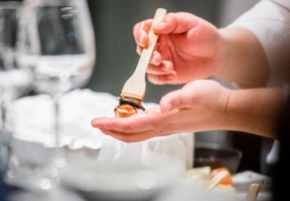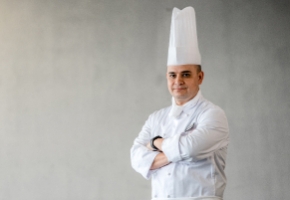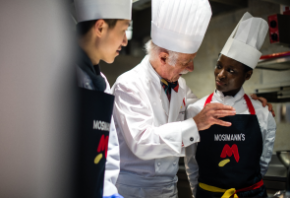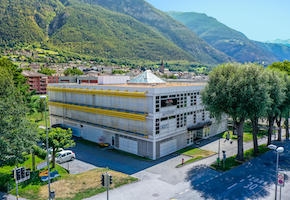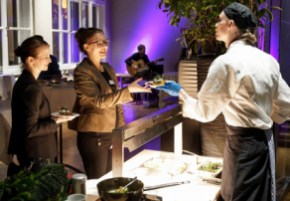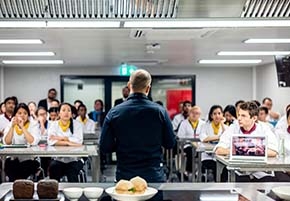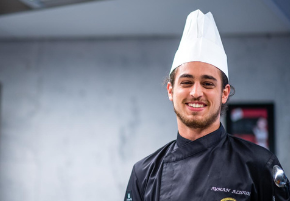- About
- Programs
- Campus Life
- Career Services
- Admissions
- News & Events
- Alumni
Explore the Difference Between Boulangerie and Patisserie
Discover the difference between a boulangerie and a patisserie. Learn their specialties and find out which bakery suits your taste. Find out more now!
Key Takeaways
- Boulangeries specialize in bread-making, including varieties like baguettes and rye loaves, while pâtisseries focus on creating sweet treats like cakes, tarts, and pastries.
- Pâtisserie involves delicate techniques like creaming and folding, and uses specialized tools like piping bags and pastry brushes.
- Boulangerie focuses on dough fermentation, kneading, and proofing, with tools like dough scrapers and bread lames.
- Viennoiserie combines elements of both pâtisserie and boulangerie, using yeast-leavened dough and added ingredients like butter and sugar.
Pâtisserie, boulangerie, and viennoiserie are integral to French culinary traditions, which have also greatly influenced Swiss cuisine. These terms describe distinct aspects of the pastry and bread-making arts, offering a rich array of both sweet and savory delights. Understanding the difference between boulangerie and pâtisserie, as well as viennoiserie, is essential to fully appreciate these culinary treasures.
Key Differences Between a Boulangerie and a Patisserie
The French culinary culture is often associated with three terms: pâtisserie, boulangerie, and viennoiserie. Although they all relate to baking and pastries, there are some key differences between boulangerie and pâtisserie, each offering a unique taste, texture, and cultural significance that reflects the rich culinary heritage of France.
Types of products sold
The differences between boulangerie and pâtisserie lie in the types of products they specialize in.
Pâtisserie is the art of pastry-making. It encompasses a variety of sweet treats, including cakes, tarts, pastries, and desserts. Known for its complex techniques, refined flavors, and stunning presentations, pâtisserie is a vital part of French cuisine, celebrated for its creativity and craftsmanship.
Boulangerie is the art of breadmaking. Boulangeries are bakeries that specialize in baking from scratch and selling a variety of bread types, from baguettes and croissants to sourdough and rye loaves. This art is firmly rooted in French tradition and craftsmanship, with bakers using traditional methods and high-quality ingredients to create delectable, crusty bread. Boulangeries are a common sight across France, attracting both locals and tourists in search of their daily bread.
Swiss boulangeries are known for their exceptional craftsmanship and commitment to producing high-quality bread. Whether you're looking for a classic baguette, a hearty rye loaf, or a unique Swiss specialty like Zopf, you'll find it in the local boulangeries. Be sure to try the bread from Bäckerei-Konditorei Fuchs in Basel or Boulangerie Taillens in Geneva.
Ingredients and techniques used
The culinary arts of pâtisserie and boulangerie each boast their own unique techniques and essential tools, contributing to the creation of delectable pastries, bread, and viennoiseries.
In pâtisserie, mastery of techniques is key to achieving exquisite desserts. Pastry chefs employ various methods, such as creaming, folding, and tempering, to create delicate and light pastries. Essential tools include:
- Pastry blenders for cutting butter into flour
- Piping bags for creating intricate designs
- Pastry brushes for applying glazes and egg washes
Boulangerie focuses on the mastery of dough and fermentation. Bakers use techniques like kneading, proofing, and shaping to create a wide range of bread varieties. Key tools in a baker's arsenal include:
- Dough scrapers for manipulating dough
- Bread lames for scoring the dough's surface
- Proofing baskets for shaping and supporting the dough during fermentation
Legal and certification requirements
The term "patisserie" carries a legal distinction in France, where it refers specifically to bakeries that offer a wide variety of pastries and desserts crafted by a certified pastry chef (pâtissier). A patisserie must employ a trained pâtissier to maintain its classification, as these professionals possess specialized knowledge and skills honed through formal education.
To become a certified pâtissier in just one year, you could benefit from the Swiss Diploma in Pastry Arts at Culinary Arts Academy Switzerland (CAAS). This program provides comprehensive training, equipping students with the culinary skills and knowledge needed for a successful career in pastry arts and baking.
The term "boulangerie" is also legally protected, meaning that to carry this prestigious name, a bakery must produce bread from scratch on-site, using traditional techniques. Selling pre-made, frozen, or reheated bread disqualifies a bakery from using the term "boulangerie," ensuring that customers are receiving freshly baked, handcrafted bread with every visit.
To maintain this status, bakeries must adhere to strict regulations and inspections. In addition to the standard health and safety checks, certain boulangeries need to qualify for the "Boulangerie Artisanale" certification, a prestigious label that recognizes their dedication to high-quality, artisanal bread-making.
What Is a Viennoiserie and How Does It Differ from Boulangeries and Patisseries
Viennoiserie bridges the gap between pâtisserie and boulangerie. It consists of pastries made with a yeast-leavened dough, similar to bread, but with added ingredients such as butter and sugar.
The process of making viennoiserie involves layering dough with butter to achieve its signature light and airy texture. These delights include croissants, pain au chocolat, and brioche. Viennoiserie are flaky, buttery, and perfect for breakfast or a light snack.
These baked goods originated in Vienna, Austria however, the French have adopted and perfected the art of viennoiserie, becoming famous for their expertise in crafting these delicious treats.
The Swiss have also mastered the art of viennoiserie, with places like Boulangerie Fleischli in Zurich or Les Gourmandises de Miyuko in Lausanne offering some of the finest.
Significance in Swiss Culinary Arts
Pâtisserie, boulangerie, and viennoiserie play significant roles in shaping the culinary traditions of Switzerland. Let's delve into each of these categories and explore their influence and popularity in Switzerland.
Impact of pâtisserie in Swiss cuisine
Pâtisserie, the art of pastry-making, holds a special place in Swiss cuisine. Swiss pâtisseries are renowned for their exquisite pastries, cakes, and desserts. From the classic Swiss chocolate cake to the delicate meringues, pâtisserie creations are a delight for both locals and tourists. The meticulous craftsmanship and attention to detail in Swiss pâtisserie reflect the country's dedication to culinary excellence.
Importance of boulangerie in Swiss baking traditions
Boulangerie, the art of bread-making, is deeply rooted in Swiss baking traditions. Swiss boulangeries produce a variety of bread types, each with its unique flavor and texture. From the crusty Swiss farmhouse bread to the soft and fluffy Zopf (traditional Swiss braided bread), boulangeries in Switzerland are known for their artisanal expertise. Swiss bread is a vital part of the Swiss diet, enjoyed with meals or used as the base for popular Swiss dishes like raclette and fondue.
Popularity of viennoiserie among Swiss pastry lovers
Viennoiserie, which includes a range of baked goods such as croissants, pain au chocolat, and brioche, has gained immense popularity among Swiss pastry lovers. The light and flaky texture, combined with rich flavors, make viennoiserie a favorite choice for breakfast or a sweet indulgence throughout the day. Swiss bakeries take pride in their viennoiserie offerings, often using high-quality ingredients and traditional techniques to create these delightful pastries.
Master Boulangeries and Patisseries
The rich world of pâtisserie, boulangerie, and viennoiserie offers a diverse and flavorful journey into French and Swiss baking traditions. From the delicate, artistic creations of pâtisserie to the hearty, time-honored loaves of boulangerie, and the buttery, flaky viennoiseries, each category showcases unique techniques and flavors that reflect centuries of craftsmanship and cultural significance.
Whether you’re savoring a freshly baked baguette, indulging in a delicate tart, or enjoying the melt-in-your-mouth layers of a croissant, the artistry behind these baked goods speaks to the passion and expertise passed down through generations. But imagine taking it a step further—creating pastries that transport people to different corners of the world with every bite.
In just one year, you can gain the skills to do exactly that. Our Swiss Diploma in Pastry Arts will equip you with the knowledge and culinary skills needed to craft both traditional and modern delights in state-of-the-art facilities.
Frequently Asked Questions
Can a bakery be both a boulangerie and a patisserie?
Yes, a bakery can be both a boulangerie and a pâtisserie if it offers both bread and pastries.
Are boulangeries and patisseries common outside of France?
Yes, boulangeries and patisseries are common outside of France, especially in countries with French culinary influence, such as Switzerland, Belgium, and Canada
Interested in learning pastry arts? Discover our Swiss Diploma in Pastry Arts program.
